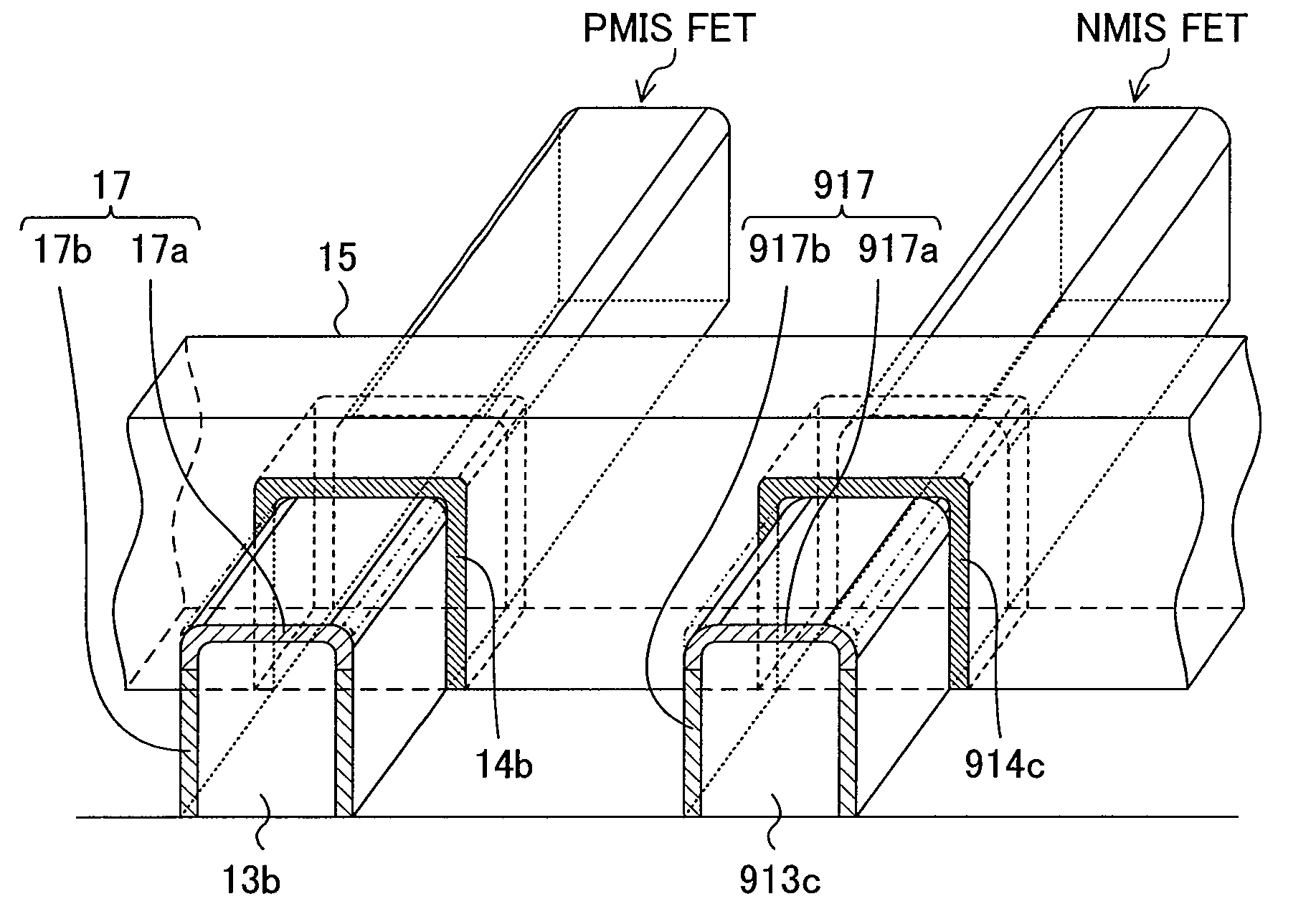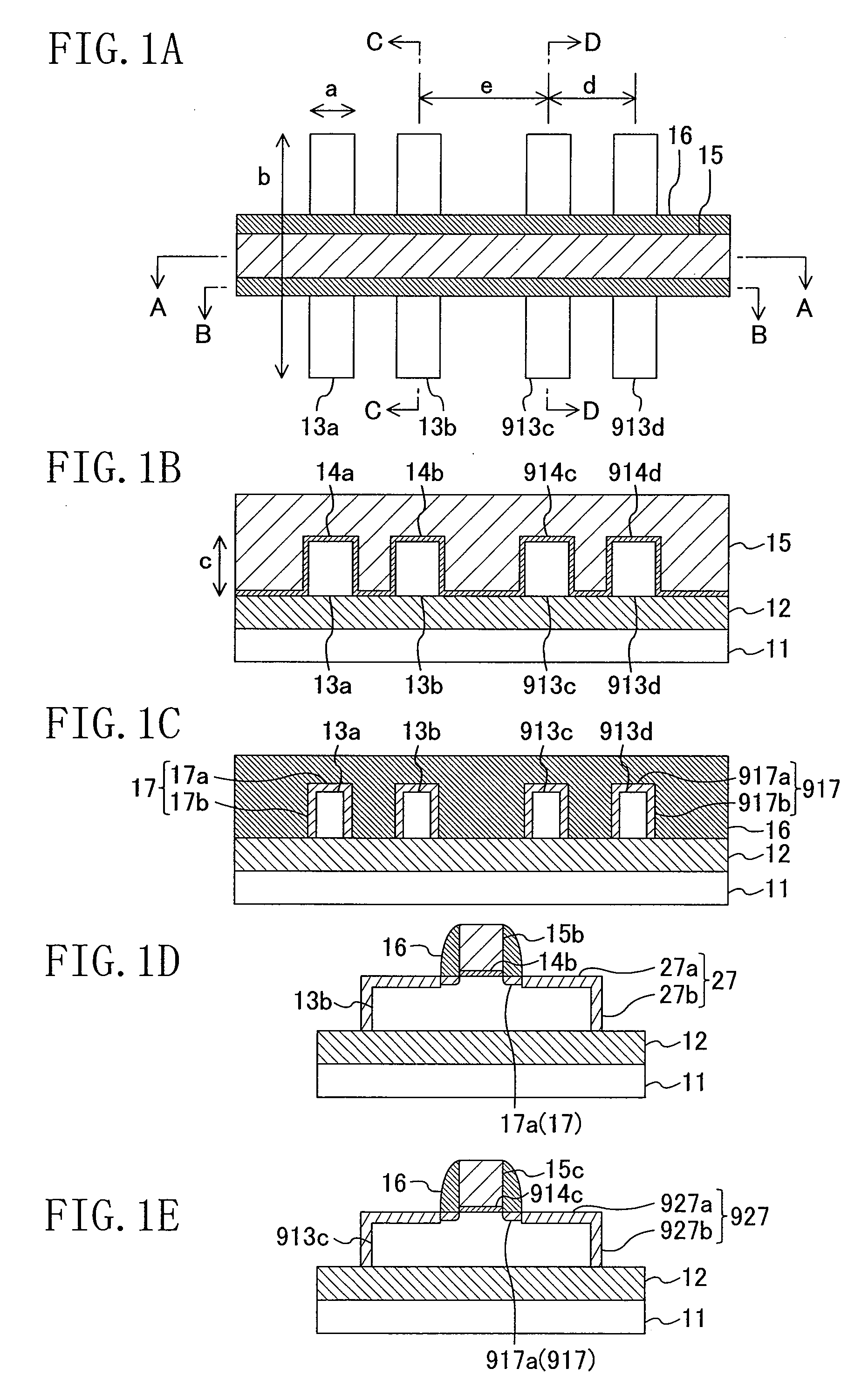Semiconductor device and method for producing the same
a technology of semiconductor devices and semiconductors, applied in the direction of semiconductor devices, electrical devices, transistors, etc., can solve the problems of not being able to obtain desirable transistor characteristics, and achieve the effects of reducing ion density, and reducing plasma doping pressur
- Summary
- Abstract
- Description
- Claims
- Application Information
AI Technical Summary
Benefits of technology
Problems solved by technology
Method used
Image
Examples
first example
[0139]FIG. 5A is a perspective view of an example (first example) of a fin-shaped CMISFET, and FIG. 5B is an enlarged perspective view showing an NMISFET of the fin-shaped CMISFET shown in FIG. 5A. In FIGS. 5A and 5B, like elements to those of the fin-shaped CMISFET shown in FIGS. 1A-1E are denoted by like reference numerals and will not be described redundantly.
[0140]First, referring to FIG. 5B, the chipping of the fin corner portion (the upper corner) of a fin-shaped NMISFET will be described. This similarly applies to the chipping of the fin corner portion of a fin-shaped PMISFET. As shown in FIG. 5B, the gate electrode 15c is formed so as to extend across the p-type fin-shaped semiconductor region 913c having the n-type impurity region 917a in an upper portion thereof and the n-type impurity region 917b in a side portion thereof, with the gate insulating film 914c interposed therebetween. Herein, the height and the width of the p-type fin-shaped semiconductor region 913c (and th...
second example
[0197]FIG. 20A is a perspective view of another example (second example) of a fin-shaped CMISFET, and FIG. 20B is an enlarged perspective view showing an NMISFET of the fin-shaped CMISFET shown in FIG. 20A. In FIGS. 20A and 20B, like elements to those of the fin-shaped CMISFET shown in FIGS. 1A-1E are denoted by like reference numerals and will not be described redundantly.
[0198]First, referring to FIG. 20B, the chipping of the fin corner portion (the upper corner) of a fin-shaped NMISFET, and the specific resistance of the n-type impurity region in the fin upper portion and that of the n-type impurity region in the fin side portion will be described. They similarly apply to a fin-shaped PMISFET. While “specific resistance (resistivity)” is mainly used in the following description, the magnitude of the resistance can be represented by “sheet resistance” or “spreading resistance” instead of “specific resistance”. As shown in FIG. 20B, the gate electrode 15c is formed so as to extend ...
first embodiment
Second Variation of First Embodiment
[0224]A structure of a semiconductor device according to a second variation of the first embodiment (including the first example and the second example) will now be described with reference to the drawings.
[0225]A plan view showing a structure of a semiconductor device of this variation, specifically, a semiconductor device including a fin-shaped CMISFET, is the same as FIG. 1A being a plan view of the first embodiment. FIGS. 25A-25D show cross-sectional structures of the semiconductor device of this variation, wherein FIG. 25A is a cross-sectional view taken along line A-A in FIG. 1A, FIG. 25B is a cross-sectional view taken along line B-B in FIG. 1A, FIG. 25C is a cross-sectional view taken along line C-C in FIG. 1A, and FIG. 25D is a cross-sectional view taken along line D-D in FIG. 1A.
[0226]As shown in FIGS. 25A-25D, this variation differs from the first embodiment shown in FIGS. 1A-1E as follows. That is, in the first embodiment, the gate ins...
PUM
 Login to View More
Login to View More Abstract
Description
Claims
Application Information
 Login to View More
Login to View More - R&D
- Intellectual Property
- Life Sciences
- Materials
- Tech Scout
- Unparalleled Data Quality
- Higher Quality Content
- 60% Fewer Hallucinations
Browse by: Latest US Patents, China's latest patents, Technical Efficacy Thesaurus, Application Domain, Technology Topic, Popular Technical Reports.
© 2025 PatSnap. All rights reserved.Legal|Privacy policy|Modern Slavery Act Transparency Statement|Sitemap|About US| Contact US: help@patsnap.com



